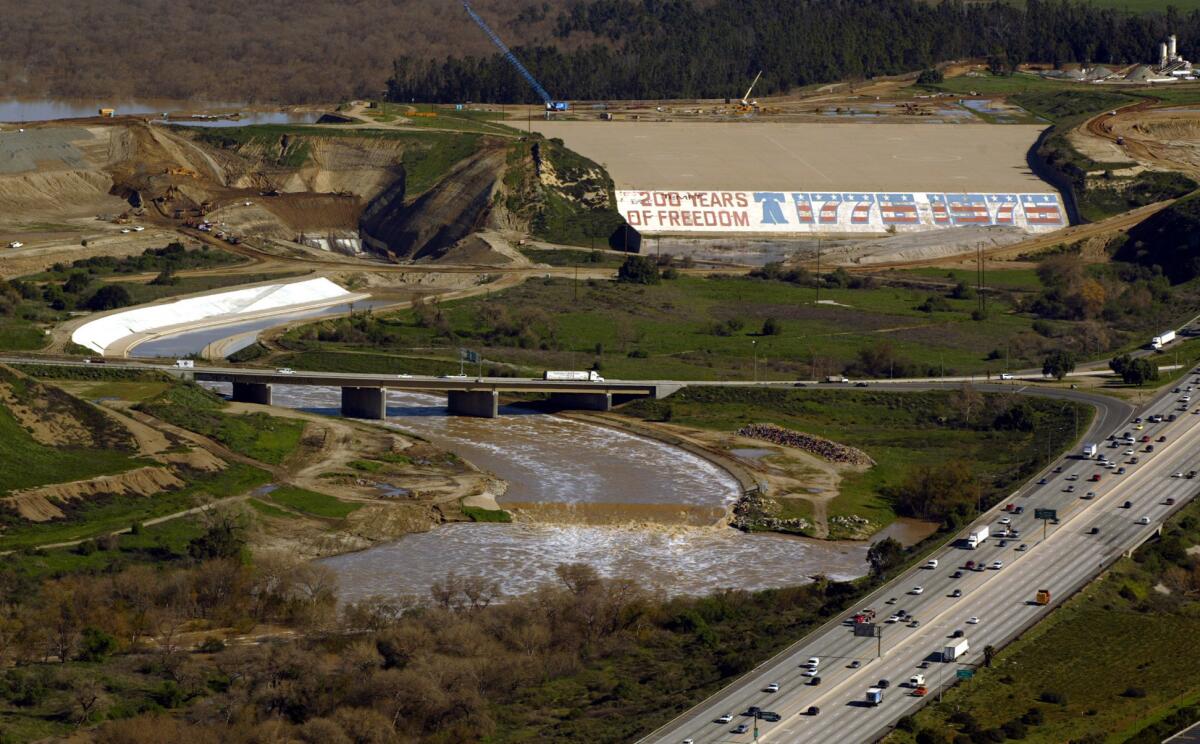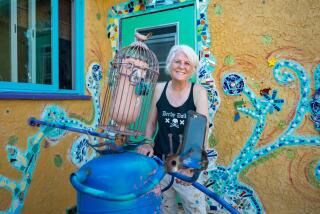Court order halts destruction of Prado Dam bicentennial mural in Corona

The bicentennial mural painted on the Prado Dam spillway in Corona, shown here in 2005, greets motorists entering Riverside County at the intersection of the 91 and 71 freeways. Residents of the area are fighting a plan to remove it.
For almost four decades, the red, white and blue mural painted on the Prado Dam spillway in Corona has greeted motorists at the juncture of the 71 and 91 freeways in Riverside County. Created and painted by students at nearby Corona High School in the spring of 1976, the mural honored the nation’s bicentennial with a simple image of the Liberty Bell and the phrase “200 Years of Freedom, 1776-1976.” Over time, it has become one of the region’s more iconic, unofficial freeway landmarks.
But a plan by the Army Corps of Engineers would do away with the mural over concerns about lead paint and the mural’s deteriorated state. (At one point in recent years, “1776” was tagged over by a graffiti artist who replaced the numerals with a giant roller tag reading “TOPS.”)
However, a group of citizens from the area — among them, one of the mural’s original designers — along with the Mural Conservancy of Los Angeles are fighting the plan.
Last week, just 12 hours before removal was set to begin, the group secured a temporary restraining order from a federal judge in Riverside on the grounds that removal of the mural violates the federal Visual Artists Rights Act, which outlaws the destruction of an artist’s work without providing fair notice.
“It was pretty dramatic,” says Eric Bjorgum, an intellectual property rights lawyer and partner at Karish & Bjorgum in Pasadena. “We got the restraining order on Wednesday at 7 p.m. They were going to remove it on Thursday. That’s America: a federal judge stopping the federal government from doing something.”
Bjorgum, who also sits on the board of the Mural Conservancy, was on the team that represented artist Kent Twitchell in his case against the U.S. government and numerous subcontractors in 2008, after Twitchell’s six-story mural of Ed Ruscha in downtown Los Angeles was painted over without warning in 2006. (The case was settled in Twitchell’s favor in 2008, with the artist receiving a reported payout of $1.1 million.)
The Prado Dam case goes back to U.S. District Court in Riverside on July 13, when the Mural Conservancy’s legal team will seek an injunction against the mural’s removal.
“The mural is faded and would need to be brought back,” he says. “But if you’ve seen the other work the Mural Conservancy has done, it could be fixed very easily. It’s something that we think is important to the community and is important to go through these hoops to save it.”
But the Army Corps of Engineers says that the lead paint is a problem.
“Our team evaluated the hazards to the existing mural and based upon testing decided that it contained lead-based paints,” says Suneet Sahgal, the Corps’ project manager for mural removal. “It is a huge environmental hazard for us. It is tagged. It has lots of graffiti on it. It’s an eyesore.”
Bjorgum, however, says that the lead paint issue isn’t as bad as it’s being made out to be.
“We don’t think it’s damning,” he says. “We think it can be fixed.”
The lead paint analysis was completed in May 2014 by Eco & Associates, an environmental consulting firm based in Orange County. The report determined that four out of the nine paints used in the mural do indeed contain lead in varying levels. (Lead paint wasn’t outlawed until two years after the mural was painted.)
But a study of the soil gathered directly downstream from the spillway indicated that “no sample was above the California Human Health Screening Level of 80 mg/kg for shallow residential soils and are within background levels for California and Riverside.”
The environmental study recommended that the mural should be encapsulated to prevent pollution or removed entirely using proper abatement procedures for lead paint.
Saghal says that encapsulating the mural was discarded because the price was simply too high — and because the graffiti that was now layered onto the site would make that complicated.
In the meantime, the removal plan has kicked off an outcry. Peter Usle, a former Chino resident who lived in the area when the dam was painted, helped launch a website, friendsofthepradodammural.com, which offers regular updates on the status of the dam. And, at press time, a petition on Change.org in support of the mural had garnered more than 11,000 signatures — along with 4,000 comments.
Ron Kammeyer, the Corona native who designed the mural with classmate Perry Schaefer in 1976, is flummoxed by the plan to destroy it.
“I don’t understand why they would want to completely get rid of it,” he says. “We’re only 10 years away from the bicentennial’s 50th anniversary. We don’t have very many things left from the bicentennial. And at 50 years, this becomes historical.”
Isabel Rojas-Williams, executive director at the Mural Conservancy, says the mural is worth preserving for that very reason.
“It’s so important that this mural still exists,” she says. “The fact that it’s made by schoolkids is very relevant. They created a symbol for their community, for their country. This is a place where thousands of drivers go everyday.”
Kammeyer, who now works as a landscape architect, says he approached the Army Corps of Engineers about a dozen years ago to help restore and maintain the work.
“I went to them and said, ‘It won’t cost you guys anything,’” he recalls. “‘The Boy Scouts will give me some Scouts. Home Depot will give us the paint. We’ll get the insurance.’ They said no.”
A spokesperson for the corps says that such offers were rejected as they undertook studies for a modernization plan — since it was unclear whether the spillway would survive in its current form. The plan is now done and the spillway will remain in place. But in the intervening years the mural has degraded.
“We recognize the symbolism of this mural,” says Sahgal. “We are committed to engage them on any future design. We are looking to the public for their involvement in any future murals. We realize that it has significance for them.”
But a new mural won’t be the old one, which over the decades has become part of the local landscape: one of the biggest — if not the biggest — bicentennial mural in the U.S.
“The first time I went out there with our drums of white paint, I thought this is just too big,” recalls Kammeyer, who was a junior when his design was chosen. “I was like, ‘Are you sure we can do this?’ Well, we did it.”
Find me on Twitter @cmonstah.
More to Read
The biggest entertainment stories
Get our big stories about Hollywood, film, television, music, arts, culture and more right in your inbox as soon as they publish.
You may occasionally receive promotional content from the Los Angeles Times.











